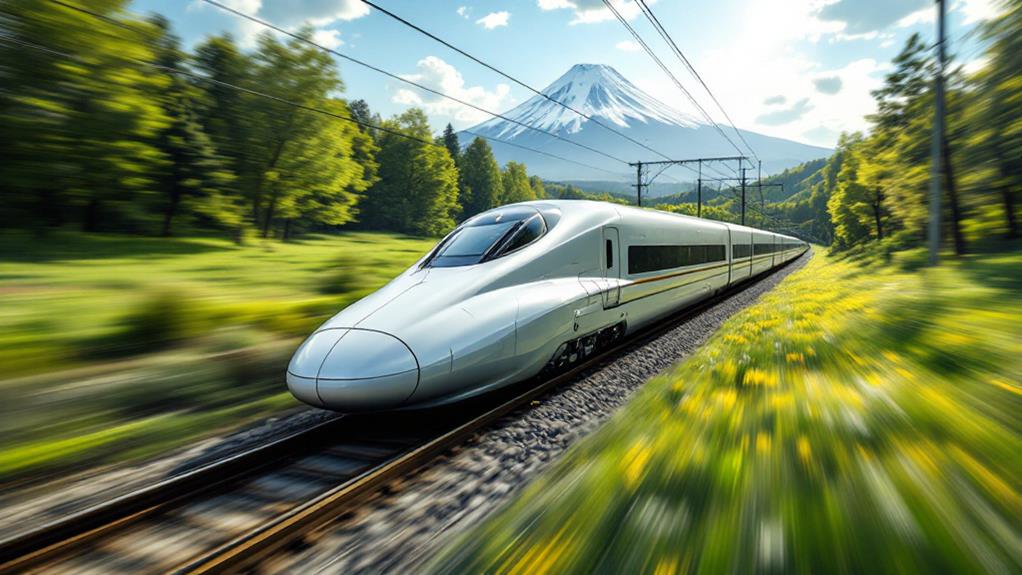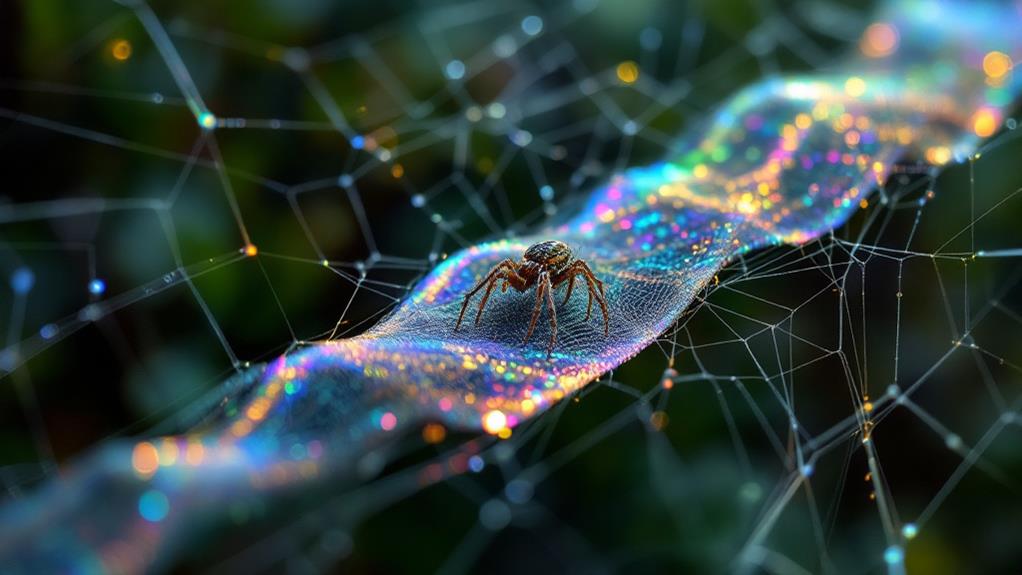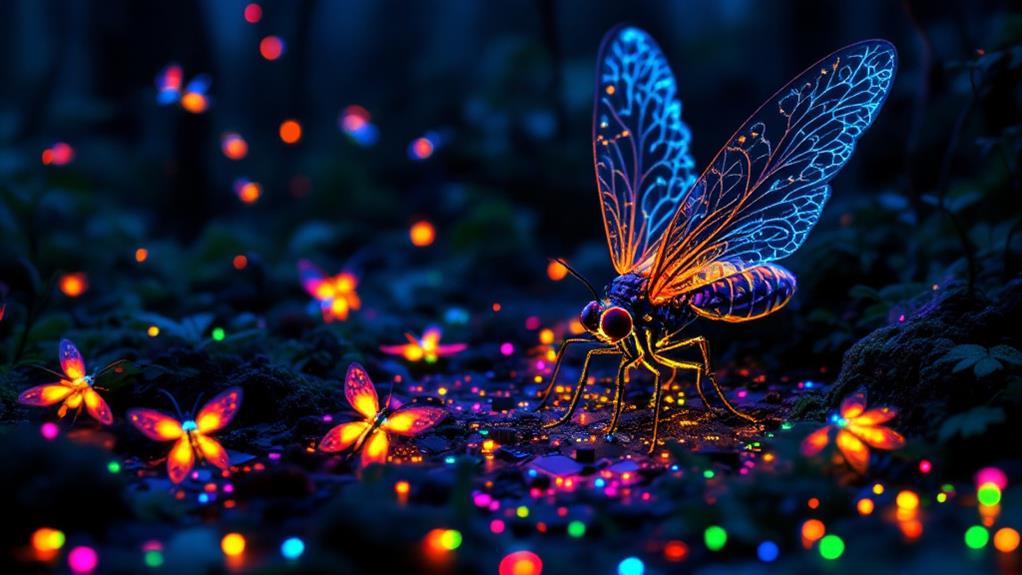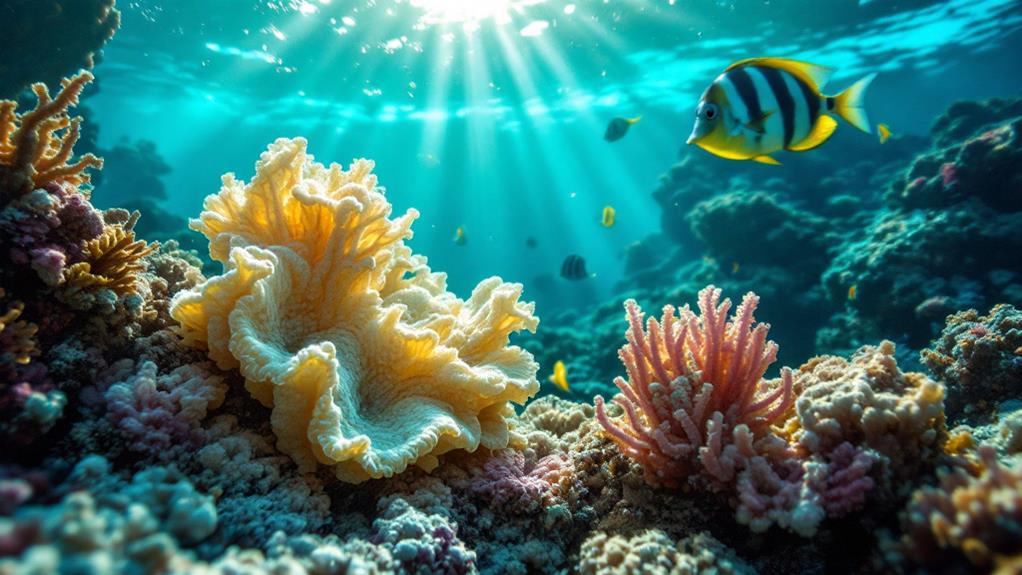Amazing Inventions Inspired by Animals and Plants: Nature’s Influence on Technology
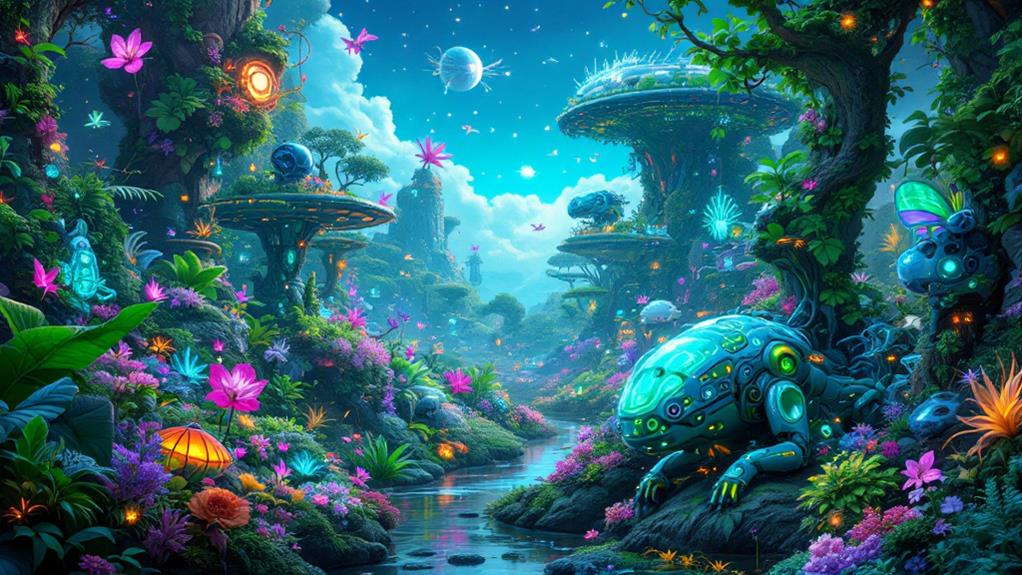
You're witnessing a fascinating age where nature's designs inspire revolutionary technologies. Imagine adhesives without stickiness, thanks to the gecko's grip, or a train that races quietly because of the kingfisher's beak. Think of wind turbines that harness energy more efficiently, mimicking whale flippers, and surfaces that clean themselves like the lotus leaf. Even Sharkskin inspires coatings that reduce drag on ships. Butterfly wings lead to lively screen displays, and termite mounds influence sustainable building ventilation. Hummingbird flight mechanics improve drone agility. Nature's ingenuity is profoundly reshaping modern technology, offering solutions to challenges we face today and more revelations await.
Gecko-Inspired Adhesives
Imagine walking up a wall as effortlessly as a gecko. This incredible ability is thanks to the gecko's unique grip, which has fascinated scientists and inspired groundbreaking adhesive technology. When you think about it, a gecko's grip isn't about sticky substances but rather the microscopic structures on its feet. These structures, called setae, enable geckos to adhere to surfaces through van der Waals forces.
Now, imagine harnessing this natural marvel in everyday applications. Engineers and researchers have been doing just that, creating adhesives that mimic the gecko's grip. Unlike traditional sticky tapes or glues, these gecko-inspired adhesives rely on physical rather than chemical bonding. Such innovation offers advantages in numerous fields, from medical devices to robotics.
Consider how this technology could change your day-to-day life. Picture using hooks that leave no residue or climbing gear that offers exceptional safety. The potential uses are vast and exciting. By translating the gecko's natural abilities into practical applications, scientists are opening doors to new innovations. You can see nature's genius applied directly to technology, providing solutions that are both efficient and environmentally friendly.
Kingfisher-Inspired Train Design
Thanks to the kingfisher's unique beak design, engineers have transformed high-speed train technology. By observing the bird's ability to plunge seamlessly into water with minimal splash, they've changed train noses for streamlined aerodynamics. You might wonder how this relates to trains—it's all about reducing air resistance and noise. The kingfisher's beak narrows gradually, which inspired engineers to reshape train fronts, allowing them to glide through air more smoothly. This design not only minimizes noise pollution but also contributes to energy efficient locomotion.
By adopting this avian-inspired shape, trains can travel faster while using less energy. The result? A more sustainable mode of transport that benefits both passengers and the environment. Here's how the kingfisher's design impacts train technology:
- Reduced Drag: The streamlined shape cuts through air resistance, boosting speed and efficiency.
- Lower Energy Consumption: With less drag, trains use less power, making them more eco-friendly.
- Noise Reduction: The design reduces noise levels, especially significant for urban areas.
- Improved Passenger Comfort: A smoother ride with fewer disruptions improves the travel experience.
This groundbreaking approach illustrates how nature's designs can lead to remarkable technological advancements.
Whale-Inspired Wind Turbines
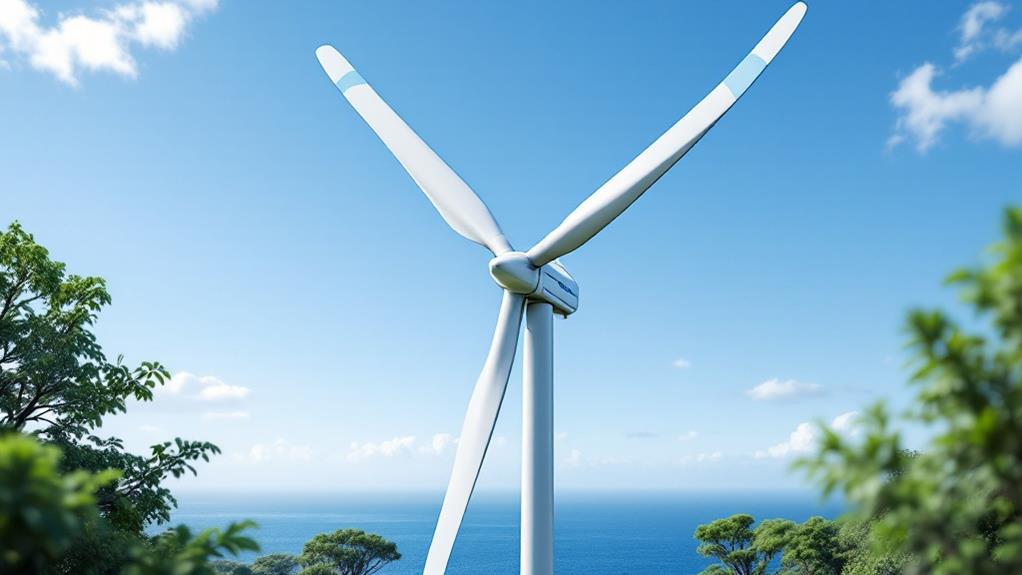
When designing wind turbines, engineers have turned to the ocean's giants for inspiration, specifically the humpback whale. These magnificent creatures master the seas with their unique flippers, characterized by distinct bumps called tubercles. By studying whale biomechanics, engineers uncovered these tubercles reduce drag and enhance lift. This insight led to the development of more efficient wind turbine blades, which mimic the whale's flippers to harness wind more effectively.
Imagine a wind turbine with blades that look a bit different from the usual smooth, straight-edge design. These biomimetic blades have a serrated edge, much like the humpback's flippers. This design minimizes turbulence and allows the turbines to operate efficiently even at lower wind speeds, capturing more of the wind's kinetic energy and converting it into electricity. By adopting this whale-inspired approach, you're able to make strides in renewable energy technology, enhancing the turbines' performance and reliability.
Integrating these innovations into wind turbines not only elevates energy output but also contributes to a more sustainable future. It's a perfect example of how nature's wisdom can lead to technological advancements that benefit both the environment and society.
Lotus Leaf Self-Cleaning Surfaces
Glimpse into the wonders of nature with the lotus leaf, whose remarkable self-cleaning properties have inspired a leap in surface technology. Imagine walking through a garden after rain and noticing how the lotus leaves repel water, keeping themselves pristine. This phenomenon, known as the "lotus effect," is due to the microscopic structures on the leaf's surface. These structures cause water droplets to bead up and roll off, carrying away dirt and debris.
Now, think about how this lotus leaf property has been translated into self-cleaning technology. Engineers and scientists have mimicked these natural structures to create surfaces that resist dirt and moisture. This technology is applied in multiple fields, offering practical benefits in everyday life.
- Easy Maintenance: Surfaces require less cleaning, saving time and resources.
- Enhanced Durability: Self-cleaning surfaces are less prone to wear and tear, extending their lifespan.
- Eco-Friendly: Reduces the need for harsh cleaning chemicals, benefiting the environment.
- Versatile Applications: Used in textiles, glass, and paints, broadening their utility.
Sharkskin-Inspired Surface Coatings
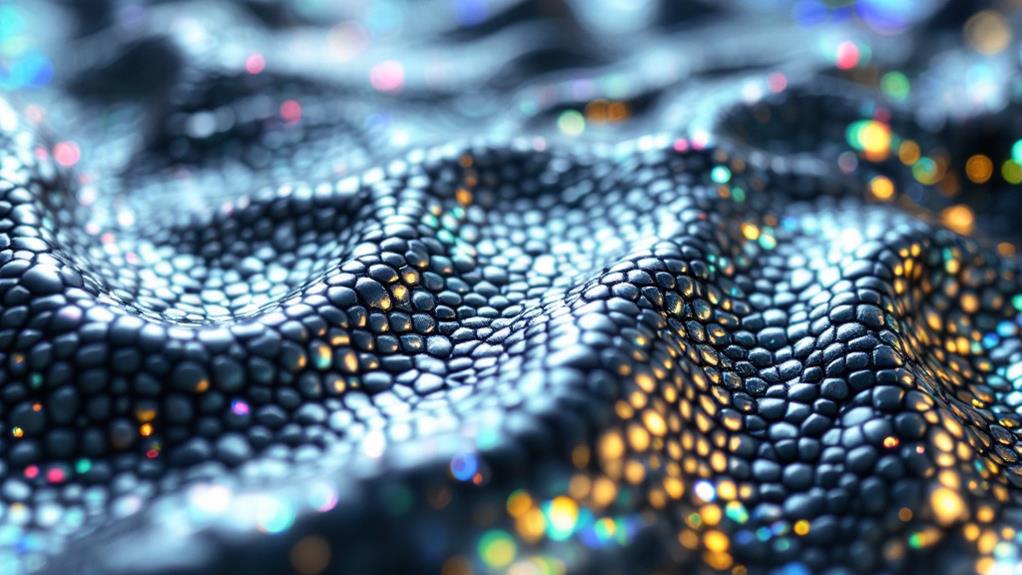
Just as the lotus leaf has inspired self-cleaning innovations, nature's ingenuity continues to spark technological advancements through the fascinating design of sharkskin. You might wonder how this unique texture influences technology. Sharkskin's microscopic patterns reduce drag and improve movement through water, making it an excellent model for advancing surface hydrodynamics in different industries. By mimicking these natural designs, scientists have developed biomimetic materials that replicate sharkskin's efficiency.
Imagine applying this technology to ships and aircraft. Coatings inspired by sharkskin can minimize drag, resulting in significant fuel savings and reduced environmental impact. But it doesn't stop there; these coatings also find applications in medical devices. The unique texture can help prevent bacterial growth, making surfaces more hygienic.
As you investigate sharkskin-inspired surface coatings, consider their potential to revolutionize everyday life. From reducing energy consumption in transportation to creating cleaner environments in healthcare, these biomimetic materials showcase how nature's designs can address modern challenges. By looking closely at the natural world, you're tapping into a reservoir of inspiration that can lead to groundbreaking innovations and sustainable solutions. Accept the potential of nature's blueprints to transform technology and improve our world.
Butterfly Wing Display Technology
Few things captivate the eye quite like the vivid colors of a butterfly's wing. But have you ever wondered how these iridescent colors come to be? It's not just about pigments but rather the microscopic structure of the wings that refracts light, creating striking colors. This natural wonder has inspired modern display technology, leading to screens that are more colorful and energy-efficient. Imagine your smartphone or TV screen reflecting the same radiant qualities as a butterfly's wing. Researchers are developing display screens that mimic these structures, providing bright, clear visuals even in direct sunlight.
Imagine using this technology not just for striking displays but also for optical camouflage. Just like a butterfly can blend into its surroundings, future devices could adapt their appearance to match their environment. Picture electronic billboards that change color based on the time of day or digital devices that become nearly invisible when not in use.
Consider this:
- Energy Efficiency: Mimicking butterfly wings could lead to devices that consume less power.
- Durability: Natural structures offer insights into creating longer-lasting screens.
- Sustainability: Using biomimicry can reduce the need for harmful materials.
- Aesthetic Appeal: Displays inspired by nature offer unparalleled beauty.
Termite-Inspired Building Ventilation
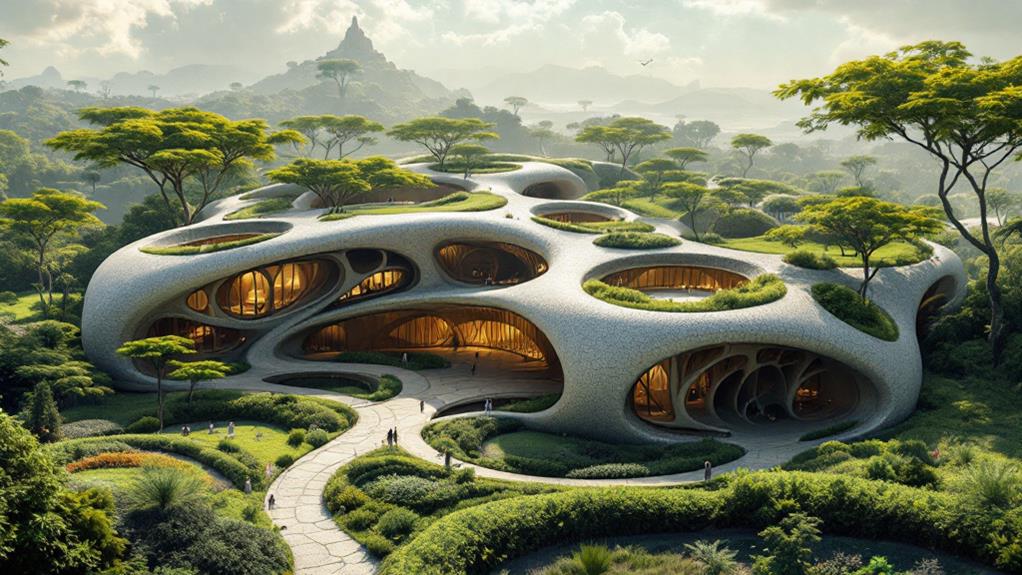
Termites might not be the initial creatures that come to mind when thinking about groundbreaking architecture, but these tiny insects have mastered the art of climate control. When you examine a termite mound, you'll find a natural marvel of engineering. These mounds maintain a stable internal temperature despite fluctuating external conditions, thanks to their unique structure. Imagine applying termite mound architecture to modern buildings. You'd be able to create energy-efficient structures that use sustainable cooling systems, reducing reliance on air conditioning.
Picture walking into a building that breathes naturally. Designers have started emulating termite mounds to achieve this effect. By incorporating a network of air vents and channels, they guarantee continuous airflow throughout the building. This ventilation system mimics the way termites manage air circulation in their mounds, regulating temperature and humidity. You can appreciate how this approach not only reduces energy consumption but also improves indoor air quality.
Hummingbird-Inspired Drones
Hummingbirds, with their remarkable agility and precision, frequently inspire advancements in drone technology. These tiny birds are masters of the sky, showcasing hummingbird flight mechanics that allow them to hover in place, dart in any direction, and perform rapid maneuvers with elegance. You can see this natural marvel reflected in the latest drone designs. Engineers study these incredible creatures to develop aerial maneuverability techniques, pushing the boundaries of what's possible in drone technology.
When you think about how hummingbirds move, consider these aspects:
- Hovering Stability: Hummingbirds can stay perfectly still mid-air, inspiring drones to replicate this by stabilizing themselves without drifting.
- Omnidirectional Flight: They can move forward, backward, and sideways effortlessly. Drones are now designed to mimic this versatility, enhancing their usefulness in tight spaces.
- Energy Efficiency: Despite their rapid wing beats, hummingbirds are energy efficient. Drones aim to emulate this efficiency, extending flight time while conserving power.
- Rapid Response: Their quick reflexes allow immediate changes in direction. Drones are being engineered with similar capabilities for applications requiring swift movements.
